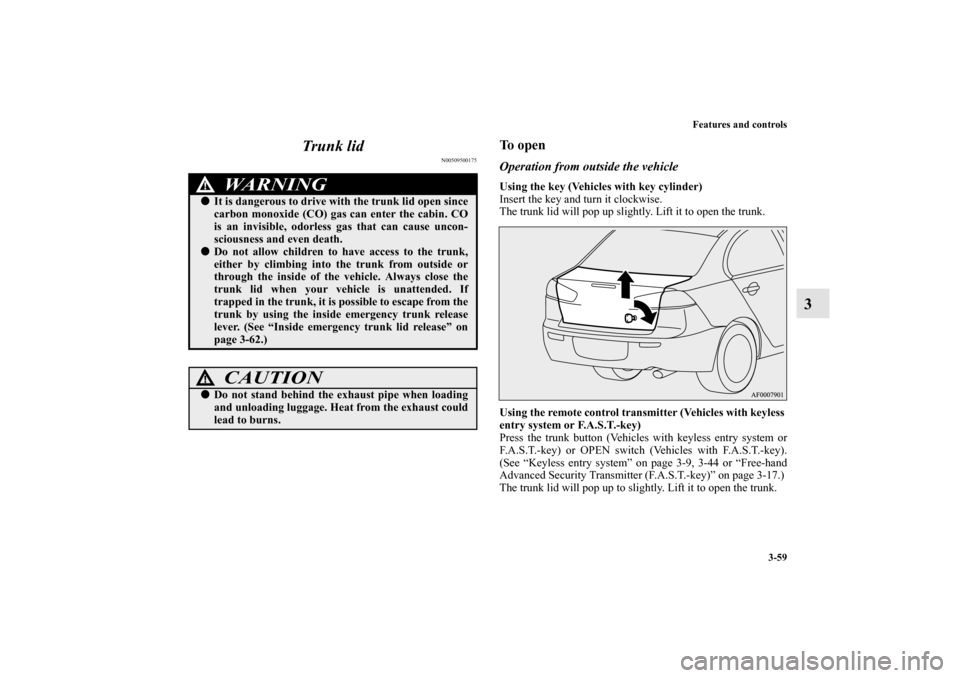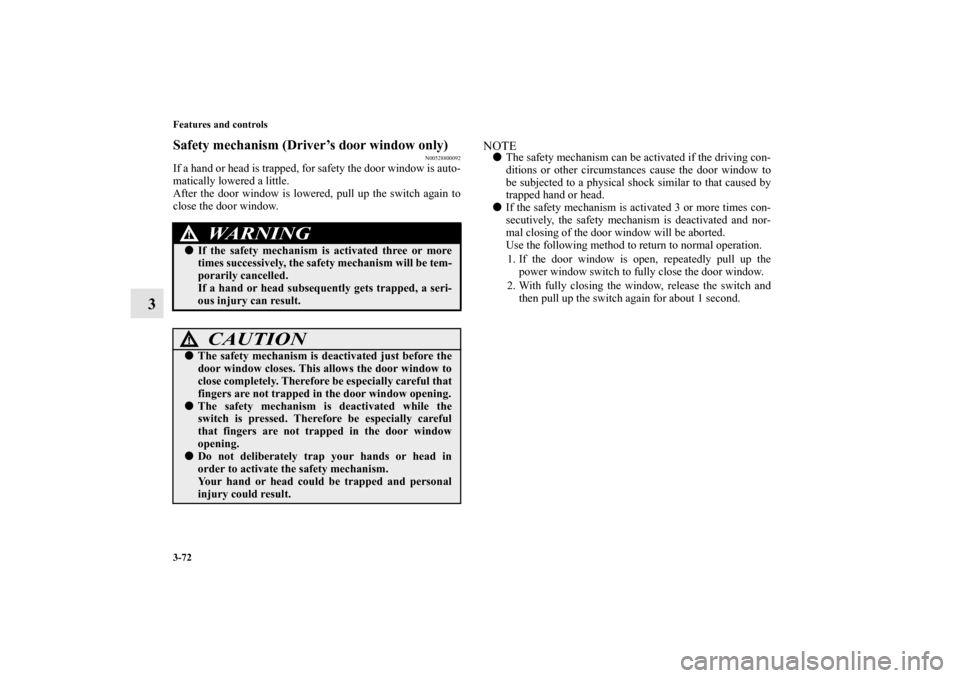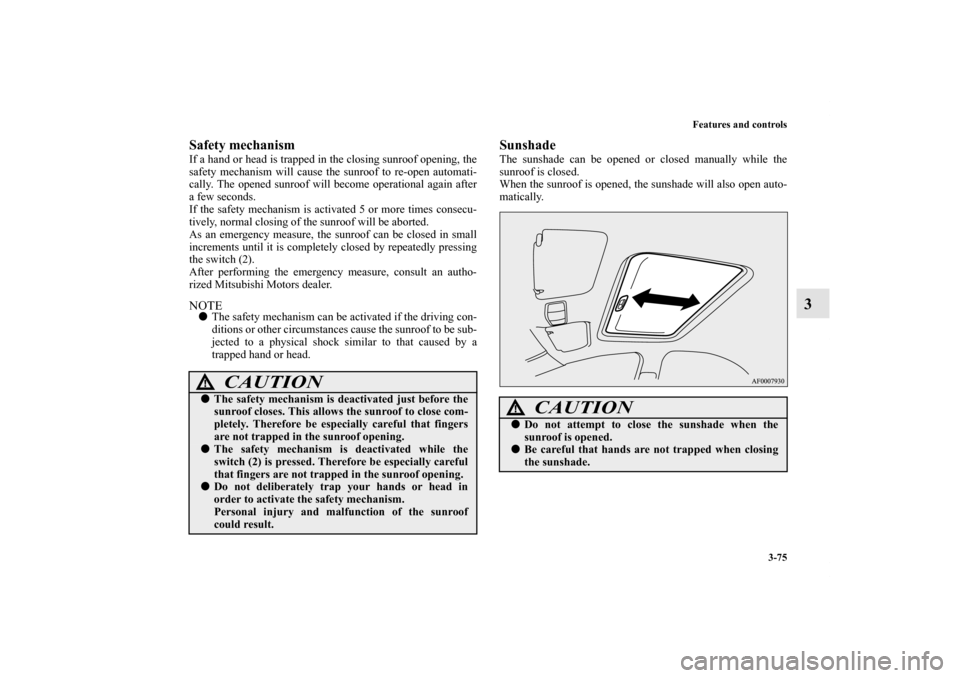Page 112 of 722

Features and controls
3-17
3 Free-hand Advanced Security Transmitter
(F.A.S.T.-key)
(if so equipped)
N00503100052
The Free-hand Advanced Security Transmitter (F.A.S.T.-key)
enables the doors to be locked and unlocked, the trunk lid to be
opened, and the engine to be started simply by carrying it.
The F.A.S.T.-key can also be used as the remote control trans-
mitter of the keyless entry system.
Refer to “Free-hand Advanced Security Transmitter (F.A.S.T.-
key)”: “Keyless entry system” on page 3-44.The F.A.S.T.-key must be carried by the driver. The F.A.S.T.-
key is required for vehicle operations such as locking and
unlocking the doors, opening the trunk lid, and starting the
engine. When leaving the vehicle, make sure you are carrying
the F.A.S.T.-key and then lock the vehicle.
WA R N I N G
!�Individuals who use implantable pacemakers or
implantable cardioverter-defibrillators should keep
away from the external and internal transmitters.
The electromagnetic waves used in the F.A.S.T.-key
may affect the operation of implantable pacemakers
and implantable cardioverter-defibrillators.
A- External transmitter
B- Internal transmitter
BK0138600US.book 17 ページ 2011年7月17日 日曜日 午後2時32分
Page 154 of 722

Features and controls
3-59
3 Trunk lid
N00509500175
To openOperation from outside the vehicleUsing the key (Vehicles with key cylinder)
Insert the key and turn it clockwise.
The trunk lid will pop up slightly. Lift it to open the trunk.
Using the remote control transmitter (Vehicles with keyless
entry system or F.A.S.T.-key)
Press the trunk button (Vehicles with keyless entry system or
F.A.S.T.-key) or OPEN switch (Vehicles with F.A.S.T.-key).
(See “Keyless entry system” on page 3-9, 3-44 or “Free-hand
Advanced Security Transmitter (F.A.S.T.-key)” on page 3-17.)
The trunk lid will pop up to slightly. Lift it to open the trunk.
WA R N I N G
!�It is dangerous to drive with the trunk lid open since
carbon monoxide (CO) gas can enter the cabin. CO
is an invisible, odorless gas that can cause uncon-
sciousness and even death.�Do not allow children to have access to the trunk,
either by climbing into the trunk from outside or
through the inside of the vehicle. Always close the
trunk lid when your vehicle is unattended. If
trapped in the trunk, it is possible to escape from the
trunk by using the inside emergency trunk release
lever. (See “Inside emergency trunk lid release” on
page 3-62.)
CAUTION
!�Do not stand behind the exhaust pipe when loading
and unloading luggage. Heat from the exhaust could
lead to burns.
BK0138600US.book 59 ページ 2011年7月17日 日曜日 午後2時32分
Page 156 of 722
Features and controls
3-61
3
To closePull the trunk lid downward as illustrated. Gently slam the
trunk lid from the outside so that it is completely closed.
Always ensure the trunk lid is securely closed.
NOTE�Gas struts (A) are installed in the locations illustrated to
support the trunk lid. Please observe the following in
order to prevent damage or faulty operation.
• Do not touch, push or pull the gas struts when closing
the trunk lid.
• Do not attach any plastic material, tape, etc., to the gas
struts.
• Do not tie string, etc., around the gas struts.
• Do not hang any object on the gas struts.
CAUTION
!�Be careful to prevent catching anyone’s fingers
when closing the trunk lid.�Before starting the vehicle, be sure to confirm that
the trunk lid is closed. If the trunk lid opens while
driving the vehicle, objects stored in the trunk could
fall out onto the road.
BK0138600US.book 61 ページ 2011年7月17日 日曜日 午後2時32分
Page 167 of 722

3-72 Features and controls
3
Safety mechanism (Driver’s door window only)
N00528800092
If a hand or head is trapped, for safety the door window is auto-
matically lowered a little.
After the door window is lowered, pull up the switch again to
close the door window.
NOTE�The safety mechanism can be activated if the driving con-
ditions or other circumstances cause the door window to
be subjected to a physical shock similar to that caused by
trapped hand or head.
�If the safety mechanism is activated 3 or more times con-
secutively, the safety mechanism is deactivated and nor-
mal closing of the door window will be aborted.
Use the following method to return to normal operation.
1. If the door window is open, repeatedly pull up the
power window switch to fully close the door window.
2. With fully closing the window, release the switch and
then pull up the switch again for about 1 second.
WA R N I N G
!�If the safety mechanism is activated three or more
times successively, the safety mechanism will be tem-
porarily cancelled.
If a hand or head subsequently gets trapped, a seri-
ous injury can result.
CAUTION
!�The safety mechanism is deactivated just before the
door window closes. This allows the door window to
close completely. Therefore be especially careful that
fingers are not trapped in the door window opening.�The safety mechanism is deactivated while the
switch is pressed. Therefore be especially careful
that fingers are not trapped in the door window
opening.�Do not deliberately trap your hands or head in
order to activate the safety mechanism.
Your hand or head could be trapped and personal
injury could result.
BK0138600US.book 72 ページ 2011年7月17日 日曜日 午後2時32分
Page 170 of 722

Features and controls
3-75
3
Safety mechanism If a hand or head is trapped in the closing sunroof opening, the
safety mechanism will cause the sunroof to re-open automati-
cally. The opened sunroof will become operational again after
a few seconds.
If the safety mechanism is activated 5 or more times consecu-
tively, normal closing of the sunroof will be aborted.
As an emergency measure, the sunroof can be closed in small
increments until it is completely closed by repeatedly pressing
the switch (2).
After performing the emergency measure, consult an autho-
rized Mitsubishi Motors dealer.NOTE�The safety mechanism can be activated if the driving con-
ditions or other circumstances cause the sunroof to be sub-
jected to a physical shock similar to that caused by a
trapped hand or head.
SunshadeThe sunshade can be opened or closed manually while the
sunroof is closed.
When the sunroof is opened, the sunshade will also open auto-
matically.
CAUTION
!�The safety mechanism is deactivated just before the
sunroof closes. This allows the sunroof to close com-
pletely. Therefore be especially careful that fingers
are not trapped in the sunroof opening.�The safety mechanism is deactivated while the
switch (2) is pressed. Therefore be especially careful
that fingers are not trapped in the sunroof opening.�Do not deliberately trap your hands or head in
order to activate the safety mechanism.
Personal injury and malfunction of the sunroof
could result.
CAUTION
!�Do not attempt to close the sunshade when the
sunroof is opened.�Be careful that hands are not trapped when closing
the sunshade.
BK0138600US.book 75 ページ 2011年7月17日 日曜日 午後2時32分
Page 174 of 722
Features and controls
3-79
3 Steering wheel tilt lock lever
N00511500215
To adjust the steering wheel height, release the tilt lock lever
while holding the steering wheel by hand, and raise or lower
the steering wheel to the desired height.
After adjustment, securely lock the lever by pulling it upward.1- Locked
2- ReleasedTy p e 1
Ty p e 2
WA R N I N G
!�After adjusting, make sure the lock lever is secured
in the locked (1) position. �Do not attempt to adjust the steering wheel while
driving. This can be dangerous.�When releasing the tilt lock lever {moving it to the
position (2)}, be sure to hold the steering wheel
firmly. Otherwise, the steering wheel may slip down
too suddenly.
BK0138600US.book 79 ページ 2011年7月17日 日曜日 午後2時32分
Page 197 of 722

3-102 Features and controls
3
When the selector lever cannot be shifted from the “P”
(PARK) position
N00563100021
When the selector lever cannot be shifted from the “P” (PARK)
position to another position while the brake pedal is pressed
and held down with the ignition switch at the “ON” position,
the battery may be flat or the shift-lock mechanism may be
malfunctioning.
Immediately have your vehicle checked by an authorized
Mitsubishi Motors dealer or a repair facility of your choice.
If you need to move the vehicle, shift the selector lever as fol-
lows.
1. Make sure the parking brake is fully applied.
2. Stop the engine if it is running.
3. Insert a screwdriver with a cloth over its tip into the notch
(A) of the cover. Pry gently as shown to remove the cover.4. Depress the brake pedal with the right foot.
5. Turn the ignition switch to the “ACC” position.
NOTE�For vehicles with the Free-hand Advanced Security
Transmitter (F.A.S.T.-key), turn the ignition switch to the
“ACC” position with the emergency key if the vehicle
battery is flat.
6. Insert a screwdriver in the shift-lock release hole (B).
Shift the selector lever to the “N” (NEUTRAL) position
while pressing the screwdriver down.
BK0138600US.book 102 ページ 2011年7月17日 日曜日 午後2時32分
Page 238 of 722

Features and controls
3-143
3 Limited-slip differential
(if so equipped)
N00517400069
A limited-slip differential is applied for rear wheel differential.
The features of this limited-slip differential are described
below:
Just as with a conventional differential, the wheel on one side
is allowed to turn at a different speed from the wheel on the
other side when the vehicle is cornering. The difference
between the limited-slip differential and a conventional differ-
ential is that if the wheel on one side of the vehicle loses trac-
tion, a greater amount of torque is applied to the wheel on the
other side to improve traction.NOTE�Even if there is a difference in the amount of traction the
wheels can get, if both of them are spinning, the limited-
slip differential will not be effective.
Service brake
N00517500262
Brake pedalOveruse of the brake can cause poor brake response and pre-
mature wear of the brake pads and linings.
When driving down a long or steep hill, use engine braking by
downshifting.
CAUTION
!�Never start the engine while one of the front or rear
wheels is jacked up and the other in contact with the
ground; doing so may cause the vehicle to jump for-
ward.�Continuously attempting to extract the vehicle from
snow, mud, etc. while using high engine rpm may
damage the limited-slip differential.�Using a compact spare wheel will adversely affect
the limited-slip differential; replace the compact
spare wheel with a standard size wheel as soon as
possible.
WA R N I N G
!�Do not leave any objects near the brake pedal or let
a floor mat slide under it; doing so could prevent the
full pedal stroke that would be necessary in an emer-
gency. Make sure that the pedal can be operated
freely at all times. Make sure the floor mat is
securely held in place.
CAUTION
!�It is important not to drive the vehicle with your foot
resting on the brake pedal when braking is not
required. This practice can result in very high brake
temperatures, premature pad and lining wear, and
possible damage to the brakes.
BK0138600US.book 143 ページ 2011年7月17日 日曜日 午後2時32分